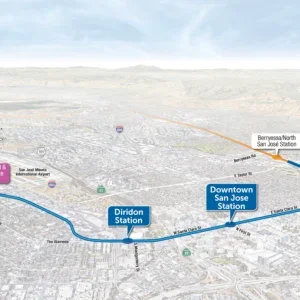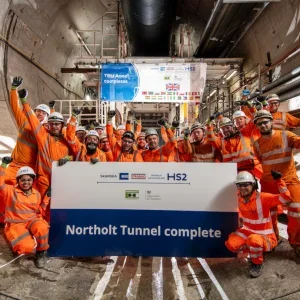The 2.6m diameter Domenica was launched in June 2021 and has completed four shaft breakthroughs along the 3.2km link sewer tunnel route in New Zealand’s largest city. The tunnel will significantly reduce wet-weather overflows by taking stormwater and wastewater to Mangere treatment plant for processing.

Central Interceptor commercial manager Nigel Varcoe described the breakthrough, which was four weeks ahead of schedule, as “a big moment”.
“We’ve been through a lot: a global pandemic, closed borders and more recently floods. To have the first link sewer tunnel completed safely and ahead of schedule is a great achievement and I’d like to pay a particular tribute to the Ghella Abergeldie JV tunnellers who have worked so efficiently to get the job done,” he said.
A crew of 15 people, working above and below ground, operated Domenica, which uses a pipe-jacking method of construction.
Domenica laid around four to five pipes per day on average and travelled up to 15m, five days per week.
Surface and permanent works delivery manager Chris McCarthny said there had been challenges.
“In November, Domenica completed the longest drive of the project (1212m) from Dundale Ave, Blockhouse Bay to Miranda Reserve. Not only was it a very long continuous drive, but the tunnel was also curved, which was technically challenging,” he said.
“The long drive was necessary because a design change removed the need for another shaft at Whitney St, which would have caused months of disruption for Blockhouse Bay residents, so we’re very grateful to the team for pulling this off.”
Domenica will now be removed for refurbishment before starting work on link sewer B in late July. This link will be just over 1km long and involve two separate drives.
Meanwhile, the Central Interceptor’s main TBM, Hiwa-i-te-Rangi, has just completed a 5km milestone on the 14.7km bore towards central Auckland.
It was launched in August 2021 and is now 115m underneath Hillsborough Ridge – the deepest section of the journey. Hiwa-i-te-Rangi travels up to 25m per day and is powered by a series of thrust cylinders. So far it has laid 3,118 steel-reinforced concrete rings to create the main tunnel, which has a 100-year lifespan.
The Central Interceptor is the largest wastewater project in New Zealand’s history. It will store 226,000m3 of wastewater, control the flows into treatment plants and reduce the number of wastewater overflows.







